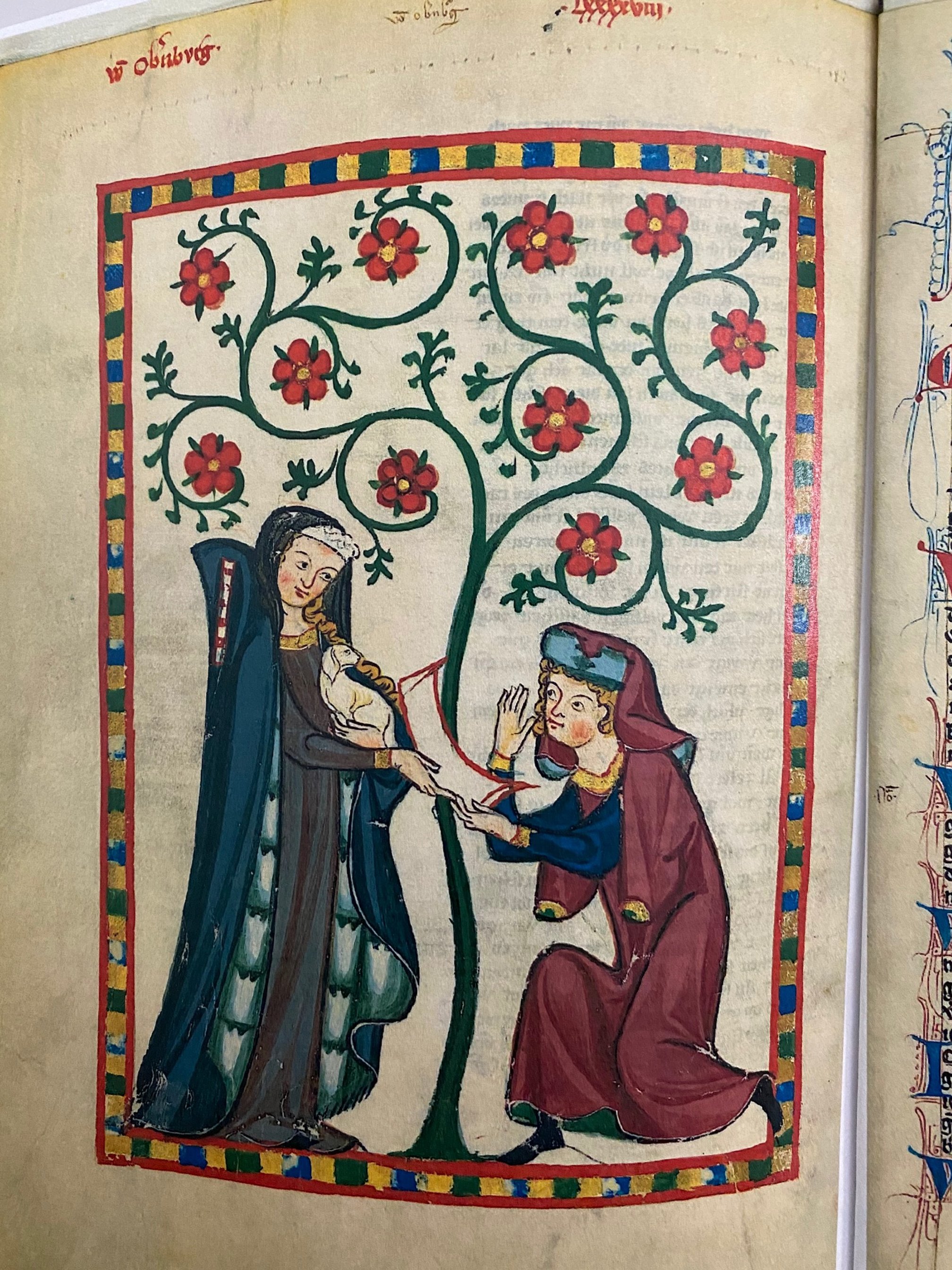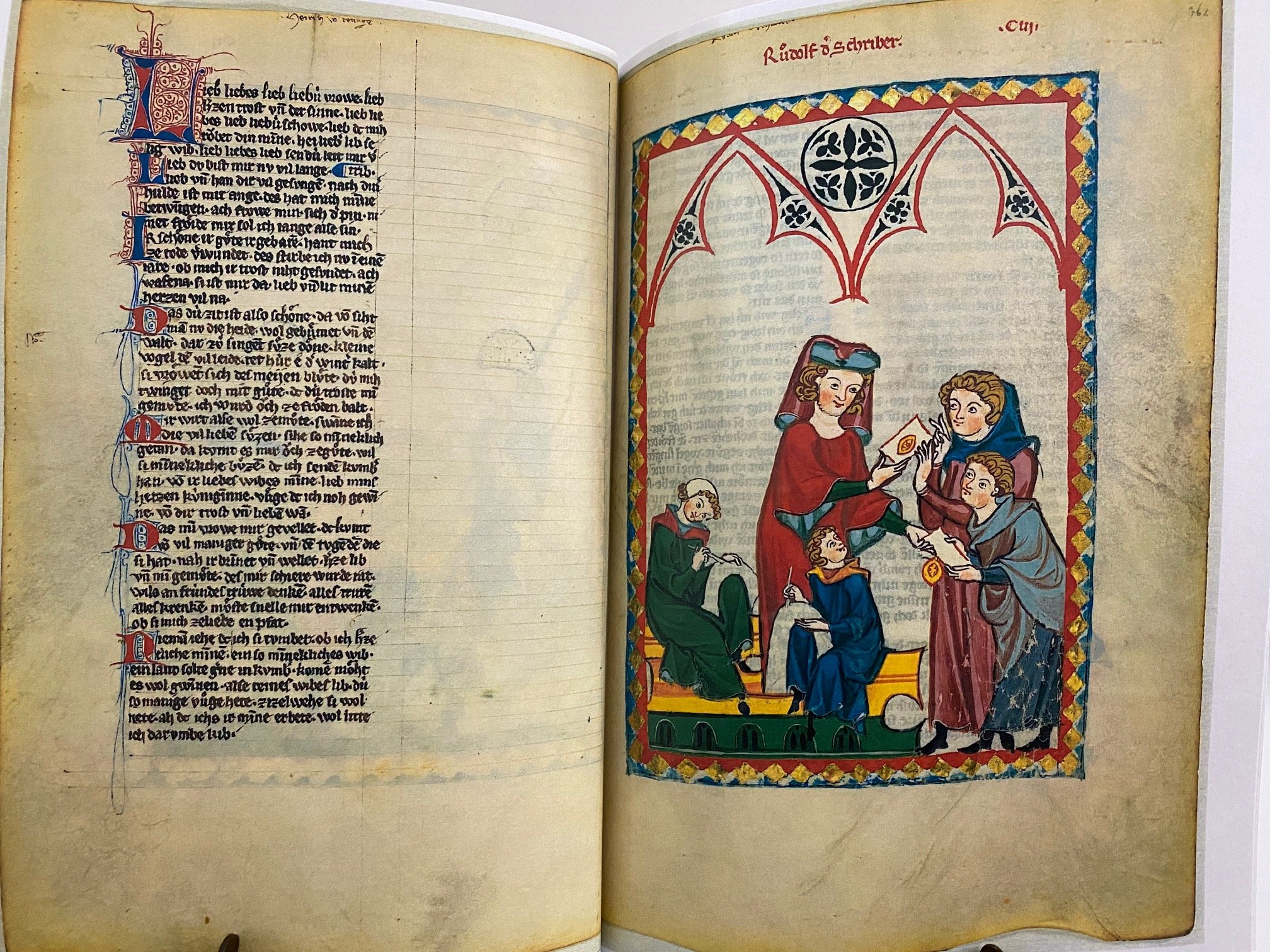Codex Manesse









Codex Manesse
Codex Manesse
Language: Middle High German
Date: 1304 for the bulk of the book - 1340 the addenda was added
PAGE # 864
PRICE: $699.99
REPRODUCTION DIMENSIONS: 8.75 x 11.25 inches
HISTORY/DESCRIPTION: The Codex Manesse the single most comprehensive source of Middle High German Minnesang poetry, written and illustrated between c. 1304 when the main part was completed, and c. 1340 with the addenda. The codex was produced in Zürich, for the Manesse family.
The manuscript contains 137 miniatures in a series of "portraits" depicting each poet. The Codex is an anthology of the works of a total of about 135[4] minnesingers of the mid 12th to early 14th century. For each poet, a portrait is shown, followed by the text of their works. The entries are ordered approximately by the social status of the poets, starting with the Holy Roman Emperor Henry VI, Kings Conradin and Wenceslaus II, down through dukes, counts and knights, to the commoners.
Most of the poems are Minnesang, but there are also other genres, including fables and didactic poems.
Below is a list of all the Poets starting with Henry VI, Holy Roman Emperor.
6r: Henry VI, Holy Roman Emperor (1165–1197)
7r: King Conrad the Young (1252–1268)
8r: "King Tyro of Scotland and Fridebrant his son" (not the name of a singer, but the title of an epic poem, dated to the first half of the 13th century)
10r: King Wenceslaus of Bohemia (Wenceslaus II, king of Bohemia and Poland, 1271–1305)
11v: Herzog Heinrich von Breslau (Henry IV, 1258–1290)
13r: Margrave Otto von Brandenburg (Otto IV, 1266–1308)
14v: Margrave Heinrich von Meißen (Henry III, 1215–1288)
17r: the Duke of Anhalt (Henry I, c. 1170–1252)
18r: John, Duke of Brabant (John I, 1252/1253–1294)
20r: Count Rudolf von Neuenburg (either Rudolf II, died 1192, or his nephew Rudolf I, died 1258)
22v: Count Kraft von Toggenburg (probably Kraft III of Toggenburg, died 1339)
24r: Count Konrad von Kirchberg (either Konrad II, fl. 1275–1326, or his cousin Konrad III, 1281–1315)
26r: Count Friedrich von Leiningen (probably Friedrich II, died 1237)
27r: Count Otto von Botenlauben (died 1244)
29r: Margrave von Hohenburg (either Diepold V. von Vohburg, fl. 1205–1225, or his son Bertold IV, died 1256).
30r: Herr Heinrich von Veldeke (died after 1184)
32v: Herr Gottfried von Neifen (died 1279)
42r: Count Albrecht von Haigerloch (Albrecht II of Hohenberg, died 1298)
43v: Count Wernher von Homberg (died 1320)
46v: Herr Jakob von Warte (died 1331)
48v: Brother Eberhard von Sax (fl. 1309)
52r: Herr Walther von Klingen (fl. 1240–1280s)
54r: Herr Rudolf von Rotenburg (fl. 1287)
59v: Herr Heinrich von Sax (probably Henry II, 1235–1289)
61v: Herr Heinrich von Frauenberg (fl. 1284–1305)
63r: Der von Kürenberg (12th century)
64r: Herr Dietmar von Aist (fl. 1140–1160s)
66v: Der von Gliers (perhaps Wilhelm von Gliers, fl. 1267–1317)
69r: Herr Wernher von Teufen (fl. 1220)
70v: Herr Heinrich von Stretlingen (either Henry II, fl. 1250s, or his son Henry III, died 1294)
71v: Herr Kristan von Hamle (probably an author of 13th-century Thuringia, otherwise unknown)
73r: Herr Ulrich von Gutenburg (fl. 1170s)
75v: Herr Heinrich von der Mure (fl. 1223–1263, a Dominican friar, prior at Eichstätt and later at Augsburg)
76v: Herr Heinrich von Morungen (fl. 1210s)
82v: Der Schenk von Limpurg (either Walther I, fl. 1230–1240s, or one of his sons, Walther II or Konrad I)
84v: Schenk Ulrich von Winterstetten (fl. 1250–1270s)
98r: Herr Reinmar der Alte (fl. late 12th century)
110r: Herr Burkart von Hohenfels (fl. 1220–1230s)
113v: Herr Hesso von Reinach (1234–1275/76)
115r: Burgrave von Lienz (fl. early 13th century)
116v: Herr Friedrich von Hausen (died after 1188)
119v: Burgrave von Rietenburg (either Henry IV. fl 1174–1184, or Otto III, fl. 1154–1185)
120v: Herr Meinloh von Sevelingen (mid-12th century)
122r: Herr Heinrich von Rugge (f. 1170s)
124r: Herr Walther von der Vogelweide (c. 1170 – c. 1230)
146r: Herr Hiltbold von Schwangau (fl. 1221–1254)
149v: Herr Wolfram von Eschenbach (c. 1170 – c. 1220)
151r: Von Singenberg, Seneschal of St. Gallen (probably Ulrich von Singenberg, fl. 1220s)
158r: Der von Sachsendorf (unknown; possibly mentioned by Ulrich von Lichtenstein as serving Frederick II of Austria)
160v: Wachsmut von Künzingen (unknown, perhaps from Clemency, Luxembourg)
162v: Herr Wilhelm von Heinzenburg (near Bad Kreuznach; probably William III fl. 1264–1292)
164v: Herr Leuthold von Seven (fl. 1218)
166v: Herr Walther von Metze (died before 1276, otherwise unknown)
169v: Herr Rubin (unknown, mid-13th century)
178r: Herr Bernger von Horheim (late 12th century)
179v: Der von Johansdorf (Albrecht, fl. 1172–1209)
181v: Herr Engelhardt von Adelnburg (either fl. 1200 or 1220s, perhaps father and son of the same name)
182v: Herr Bligger von Steinach (probably Bligger II, fl. late 12th to early 13th century)
183v: Herr Wachsmut von Mühlhausen (fl. 1267)
184v: Herr Hartmann von Aue (c. 1160 – c. 1210)
188r: Herr Reinmar von Brennenberg (fl. 1270s)
190v: Johann von Ringgenberg (probably Johann I, 1291–1350)
192v: Albrecht Marschall von Rapperswil (fl. c. 1280)
194r: Herr Otto vom Turne (of Lucerne, a late addition, fl. after 1300)
197v: Herr Goesli von Ehenhein (of Strasbourg; otherwise unknown)
201r: Der von Wildonie (probably Herrand II, married to a daughter of Ulrich of Lichtenstein)
202v: Von Suonegge (probably Konrad von Suonegge, fl. 1220–1230s)
204r: Von Scharpfenberg (of Ratschach, mid-13th century)
205r: Herr Konrad, der Schenk von Landeck (of Thurgau, 1271–1306)
213r: "Der Winsbeke" (purported author of the accompanying father-son didactic poem; it is unclear whether Winsbeke is a historical or a fictional character)
217r: "Die Winsbekin" (purported author of the accompanying mother-daughter didactic poem; it is unclear whether Winsbekin is a historical or a fictional character)
219v: "Klingsor of Hungary" (fictional character introducing the Sängerkrieg poem)
226v: Kristan von Luppin of Thuringia (fl. 1290s)
228r: Herr Heinrich Hetzbold von Weißensee (early 14th century)
229v: Der Düring (an unidentified Thuringian poet, late 13th century)
231r: Winli (an unidentified Alemannic poet, c. 1300)
237r: Herr Ulrich von Liechtenstein (c. 1200–1275)
247v: Von Munegiur (given name Ulrich, otherwise unknown)
248v: Von Raute (given name Hartwig, fl. c. 1200, otherwise unknown)
249v: Herr Konrad von Altstetten (perhaps a mayor of St. Gallen, attested 1320–1327)
251r: Herr Bruno von Hornberg (probably Bruno II, fl. 1275–1310)
252r: Herr Hug von Werbenwag (fl. mid 13th century, probably died after 1292)
253v: Der Püller (Konrad "the Apulian" von Hohenburg, probably participated in a campaign of Rudolph I against Ottokar II of Bohemia in 1278)
255r: Von Trostberg (an unidentified member of either of an Argovian or a Tyrolian family of ministeriales)
256v: Hartmann von Starkenberg (of Werdenberg-Sargans, either Hartmann I, fl. 1250s, or his son Hartmann II, fl. 1270s)
257v: Von Stadegge (Rudolph II, one of the leading Styrian minnesingers, fl. 1230–1250s)
258v: Herr Brunwart von Augheim (late 13th century)
261r: Von Stamheim (unidentified; fl. c. 1240s)
262v: Herr Goeli (of Baden, 13th century)
264r: Der Tannhäuser (of Thannhausen, fl. 1240–1260s; depicted as a member of the Teutonic Order)
271r: Von Buchheim (2nd half of 13th century)
273r: Herr Neidhart (born c. 1200 in Lower Bavaria)
281v: Meister Heinrich Teschler (of Zürich, 2nd half of 13th century, patronized by Rüdiger Manesse)
285r: Rost, Kirchherr zu Sarnen (in Zürich between 1313 and 1330. Presumed to have participated in the production of the codex as a scribe)
290r: Der Hardegger (probably Henricus de Hardegge, of Rebstein, fl. 1230–1270s)
292v: Der Schulmeister von Eßlingen (late 13th century)
295r: Walther von Breisach (without portrait)
299r: Von Wissenlo (probably Wiesloch; unidentified)
300r: Von Wengen (Burchard, fl. 1230–1270s, member of a family of ministeriales of the counts of Toggenburg)
302r: Herr Pfeffel (unidentified, mid 12th century)
303r: Der Taler (perhaps Leuthold von Tal, near Rheineck, fl. 1250)
305r: Der tugendhafte Schreiber ("The Virtuous Scribe"; unidentified, appears as a character in the Sängerkrieg)
308v: Steinmar (perhaps Berthold Steinmar von Klingnau, fl. 2nd half of 13th century)
311r: Herr Alram von Gresten (unidentified, perhaps of Gresten in Lower Austria)
312r: Herr Reinmar der Fiedler (unidentified, fl. mid 13th century)
313r: Herr Hawart (perhaps Hawardus de Holzwane, in 1258 canon at Augsburg)
314v: Herr Günther von dem Vorste (unidentified)
316v: Herr Friedrich der Knecht (unidentified, his poems are in Austro-Bavarian dialect, first half of the 13th century; the portrait shows Friedrich as a knight abducting a damsel on horseback while fighting off pursuers)
318r: Der Burggraf von Regensburg (probably Heinrich III von Stevening und Rietenburg, fl. 1126–1177)
319r: Herr Niune (unidentified; probably not a poet but the owner of a songbook used as a source in this section)
320v: Herr Geltar (unidentified; the poems are dated to between 1230 and 1250, perhaps from Lower Austria)
321v: Herr Dietmar der Setzer (unidentified; the portrait shows unmounted combat with sword and heater shield)
323r: Herr Reinmar von Zweter (fl. 1230s)
339r: Der Junge Meißner (unidentified; the poems are in Central German dialect)
342r: Der Alte Meißner (without portrait)
342v: Von Obernburg (unidentified; probably mid 13th century, of Obernburg near Celje)
344v: Bruder Wernher (unidentified; mid 13th century)
349r: Der Marner (probably marinaere "the mariner"; unidentified, but mentioned by Meister Rumslant below)
355r: Süßkind, der Jude von Trimberg (unidentified, 2nd half of the 13th century)
358r: (isolated anonymous poem)
359r: Von Buwenburg (Baumburg near Hundersingen, probably Ulrich von Buwenburg, fl. 1260)
361r: Heinrich von Dettingen (well documented during 1236–1300; of a family of ministeriales of Reichenau abbey)
362r: Rudolf der Schreiber (unidentified)
364r: Meister Gottfried von Straßburg (died c. 1210)
371r: Meister Johannes Hadlaub (of Zürich, fl. 1300, possibly the redactor of the codex)
381r: Regenbogen ("Rainbow", an unidentified Alemannic poet, depicted as a smith)
383r: Meister Konrad von Würzburg (died 1287)
394r: Kunz von Rosenheim (unidentified, perhaps not a poet but the owner of a songbook used as a source)
395r: Rubin von Rüdeger (unidentified)
396r: Der Kol von Nüssen (unidentified, perhaps of Neunzen near Zwettl; the poems date to the 1230s or 1240s)
397v: Der Dürner (unidentified, perhaps of Mengen, Swabia)
399r: Meister Heinrich Frauenlob (Heinrich von Meißen, born c. 1250)
407r: Meister Friedrich von Sonnenburg (unidentified; poems date to the 3rd quarter of the 13th century)
410r: Meister Sigeher (fl. 1250–1260s; perhaps identical with a Sicherius iuculator active in Metz, possibly a Tyrolian)
412r: Der wilde Alexander (an unidentified Alemannic poet of the late 13th century)
413v: Meister Rumslant (fl. late 13th century, of Northern Germany)
415v: Spervogel ("Sparrow"; recorded under this nickname are poems by two separate authors, with floruits in the mid and the late 12th century)
418r: Boppe (of Bonndorf, died 1320; from 1276–1305 serving as reeve of the count of Nellenburg)
422r: Der Litschauer (unidentified)
423v: Der Kanzler ("The Chancellor", 2nd half of the 13th century, possibly Alemannic)
REPRODUCTION DETAILS: OUR HARDCOVER BOOKS ARE MADE WITH REAL WOOD FOR THE INTERIOR OF THE FRONT AND BACK COVERS AS WELL AS THE SPINE. THE LEATHER IS A 4 OZ COWHIDE, FROM A SMALL SUPPLIER IN NORTH CAROLINA. THE LEATHER IS ADHERED TO THE COVERS WITH GLUE AND MOLDED INTO THE SHAPE AT THE HAND OF OUR LOCAL ARTISANS. THE SIGNATURES/PAGES ARE HANDSEWN USING A LIBRARY BINDING METHOD. THE SEWN BOOK IS BOUND WITH A STRONG ADHESIVE GLUE THAT MAKES THE BINDINGS LAST, ESPECIALLY FOR THE LARGER BOOKS. WE ALSO ADD A THICK MULL CLOTH TO THE OUTSIDE OF THE BINDING, DRYING IN BETWEEN EACH LAYER, A TRADITIONAL WAY TO MAKE THE BINDING STIFF, STRONG, AND RESILIENT FOR GENERATIONS TO COME.
NOTE: ALL OF OUR FACSIMILES ARE MADE TO ORDER. PLEASE ALLOW 4-6 WEEKS FOR NOTIFICATION OF SHIPMENT.

